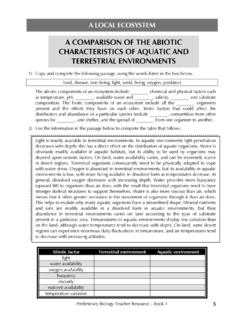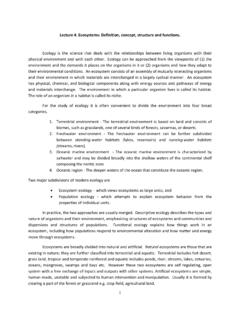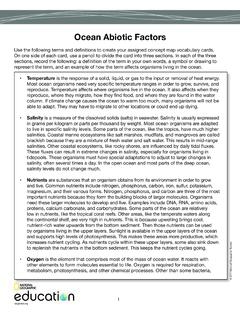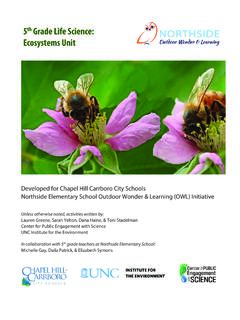Search results with tag "Abiotic"
9 The Living Organisms — Characteristics and Habitats P
ncert.nic.inthe habitat constitute its abiotic components. Are sunlight and heat biotic or abiotic components? We know that some plants gr ow fr om seeds. Let us look at some abiotic factors and their effect on seeds as they grow into young plants. Activity 2 Recall Activity 5 in Chapter 1 — we made sprouts from moong and chana seeds.
Population Ecology - WHAT YOU NEED IS HERE
getallofyouranswershere.weebly.comBiotic and Abiotic Factors 5. Organize Information Fill in the T-chart with examples of abiotic and biotic factors in an ecosystem. 6. Is a fallen, rotting tree considered an abiotic or biotic factor? Explain. A biotic factor is something that is living or used to be living. A fallen, rotting tree
Chapter 14: HAZARDOUS TO THE AQUATIC ENVIRONMENT ...
www.ilo.org6. Abiotic degradation such as hydrolysis, primary degradation, both abiotic and biotic, degradation in non-aquatic media and proven rapid degradation in the environment may all be considered in defining rapid degradability. Special guidance on data interpretation will be provided in the Guidance Document.
A COMPARISON OF THE ABIOTIC CHARACTERISTICS OF …
stage6.pbworks.comA COMPARISON OF THE ABIOTIC CHARACTERISTICS OF AQUATIC AND TERRESTRIAL ENVIRONMENTS 1) Copy and complete the following passage, using the words listed in the box below. ... CHARACTERISTICS OF AQUATIC AND TERRESTRIAL ENVIRONMENTS ANSWERS 1) Copy and complete: non-living, light, oxygen, wind, living, predators, food, disease ... Height of plants ...
Lecture 4. Ecosystems: Definition, concept, structure and ...
www.eagri.orgabiotic portion, consisting of elements that are not alive. The non living constituents are said to include the following category, habitat, gases, solar radiation, temperature, moisture and inorganic and organic nutrients. The living organisms may be sub divided into producers, consumers and decomposers. Abiotic
Chapter 9: Ecology Lesson 9.2: Biotic and Abiotic ...
www.boyertownasd.orgLesson 9.2: Biotic and Abiotic Characteristics of Terrestrial and Aquatic Biomes ... Biomes may be terrestrial or aquatic. What Are Biomes? ... plants and animals. Different terrestrial biomes are usually defined in terms of their plants, such as
Full Project Proposal - Home | Food and Agriculture ...
www.fao.orgabiotic and biotic stresses related to global climate change. 2. Detection of useful candidate genes (CG) for abiotic and associated biotic stresses applying different molecular tools. 3. Molecular characterization of the allelic variation in these CG and determination of allelic composition in the evaluated accessions. 4.
OECD GUIDELINE FOR TESTING OF CHEMICALS
www.oecd.orgAbiotic controls 19. When required, check for the possible abiotic degradation of the test substance by determining the removal of DOC, oxygen uptake or carbon dioxide evolution in sterile controls containing no inoculum. Sterilize by filtration through a membrane (0.2-0.45 µm) or by the addition of a suitable
Answer Key 1. B 41. C 81. C
www.kimberliejane.comA)biotic factors B)abiotic factors C)inorganic compounds D)finite resources 6.Which group would most likely be represented in a food chain? A)autotrophs B)hosts C)herbivores D)carnivores 7. The final consumers in many food webs are A)As the birds feed higher in the tree, available energy increases. B)More abiotic resources are available for ...
Ocean Abiotic Factors - National Geographic Society
media.nationalgeographic.orgMany factors can affect the amount of oxygen in seawater. Low oxygen levels are often a sign of water pollution and the increased activity of bacteria and other ... and the shape of the coastline and adjacent seafloor. The parts of the ocean most impacted by tides are those along the coast: salt marshes, mudflats, rocky shores, and sandy shores
Diagnosing Your Oak Tree: Part I Diseases
ceventura.ucanr.eduDec 04, 2014 · Abiotic problems occur commonly where humans have developed around oaks Vol. 19, No. 4 December 14, 2006. 2 Some misconceptions Oaks are not slow growing! When soil and water conditions are favorable, oaks grow rapidly. Coast live oak and valley oak can develop a 20-inch diameter at breast height in less than 15 years.
5th Grade Life Science: Ecosystems Unit
ie.unc.eduSep 05, 2019 · In Arc 1, students learn about the abiotic and biotic factors in ecosystems. They begin exploring the ecosystem around their schoolyard and record their observations in a nature journal. Students thentake a virtual trip down the Cape Fear River and discover different types of aquatic and terrestrial ecosystems. They explore ocean habitats
PRINCIPLES OF ECOLOGY
www.nios.ac.inenvironment namely abiotic (non-living) and biotic (living). 4.2 LEVELS OF ECOLOGICAL ORGANIZA TION Ecology not only deals with the study of the relationship of individual organisms with their environment, but also with the study of populations, communities, ecosystems, biomes, and biosphere as a whole (see Fig. 4.1)
The Major Biomes
d43fweuh3sg51.cloudfront.netbiomes is defined by a unique set of abiotic factors – particularly climate – and has a characteristic ecological community. The map shows the natural geographic distribution of these major biomes. Be aware, however; that this is just one of many different systems that are used to classify biomes. The
Earth/Environmental Science RELEASED
files.nc.govB It forms the ocean’s water and the oxygen in the atmosphere that organisms ... other important factors. What type of soil does a farmer have if the soil contains 40% sand, 40% silt, and 20% clay? A clay ... 32 Which interaction of a biotic and an abiotic factor can help stabilize a forest area in North Carolina?
Diversity is not only a characteristic of living organisms ...
www.ncert.nic.in13.1.1 Major Abiotic Factors Temperature: Temperature is the most important ecologically relevant envir onmental factor. You are aware that the average temperature on land varies seasonally, decreases progressively from the equator towards the poles and from plains to the mountain tops. It ranges from subzero
Biomes - BIOLOGY
beaconbiology.weebly.comterms of these abiotic factors. Most aquatic organisms do not have to deal with extremes of temperature or moisture. Instead, their main limiting factors are the availability of sunlight and the concentration of dissolved oxygen and nutrients in the water. These factors vary from place to place in a body of water and are used to define aquatic ...
ECOSYSTEM - National Institute of Open Schooling
www.nios.ac.inand abiotic components. (b) Biotic components (Living) (i) Producers : The green plants manufacture food for the entire ecosystem through the process of photosynthesis. Green plants are called autotrophs, as they absorb water and nutrients from the soil, carbon dioxide from the air , and capture solar ener gy for this process.
Science Georgia Standards of Excellence Seventh Grade ...
www.georgiastandards.orgcharacteristics and how that led to the six kingdom system (currently archaea, bacteria, protists, fungi, plants, and animals). ... and comparison of genotype vs. phenotype.) ... terms of the relationships among and between organisms and abiotic components of the ecosystem. (Clarification statement: The interactions include, ...
Similar queries
Organisms, Abiotic, Population, Biotic, A biotic, COMPARISON OF THE ABIOTIC CHARACTERISTICS, COMPARISON OF THE ABIOTIC CHARACTERISTICS OF AQUATIC AND TERRESTRIAL, CHARACTERISTICS OF AQUATIC AND TERRESTRIAL, Plants, 4. Ecosystems: Definition, concept, structure and, And Abiotic Characteristics of Terrestrial and Aquatic, Terrestrial, Aquatic, Full Project Proposal, OECD, Answer Key, Factors, Abiotic factors, Ocean Abiotic Factors, Shape, Ocean, Science, A characteristic of living organisms, Biomes, Ecosystem, Science Georgia Standards, Characteristics, Comparison


















